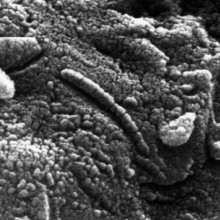Meteorites, dust and other space rubbish is falling to Earth all the time, but does any of it ever contain life? We find out if aliens hitch a lift on space rubble in this Question of the Week. Plus, we ask how does wood become petrified? Can it happen quickly enough for us to find petrified fence posts?
In this episode

00:00 - Life from Outer Space?
Life from Outer Space?
We put this to Dr Vic Pearson from the Open University:
The likelihood of finding life in meteorites is probably pretty slim. There was, in the 1990s, a big debate on whether or not NASA scientists had identified nanobacteria, so very small bacteria only identifiable using very powerful microscopes in meteorites that had come from the surface of Mars. This has pretty much been debunked now. That's not to say that the building blocks of life may not have been brought in meteorites because meteorites themselves contain biogenic elements such as sulphur, nitrogen, phosphorous. Also, carbon-based molecules or organic molecules which are required for life on Earth and elsewhere in the solar system: these are things such as amino acids, carboxylic acids, sugars - all of which make up living systems on the Earth and all of which are the backbone of the organic molecules that make up our own DNA. The chances of being able to find life elsewhere in the solar system is also a lot stronger by the fact you can find the organic molecules. Whether or not you can actually get life itself from meteorites is probably very unlikely.










Comments
Add a comment